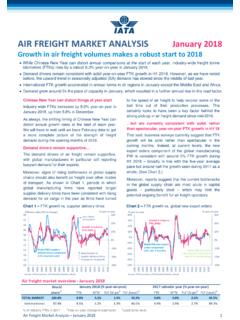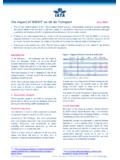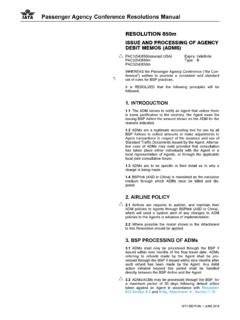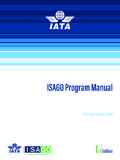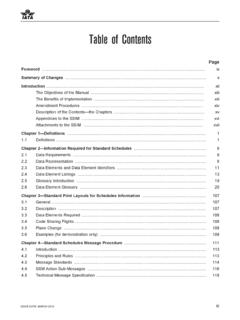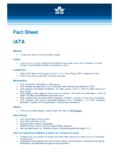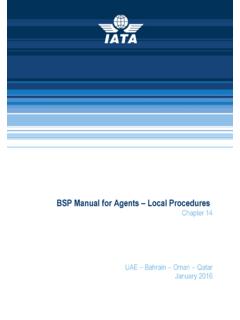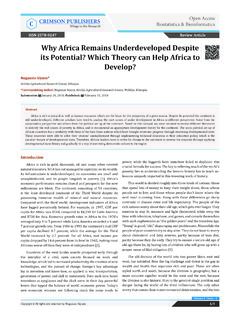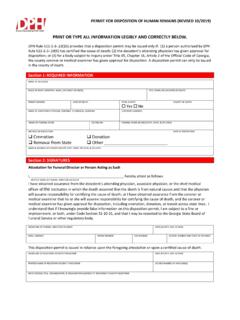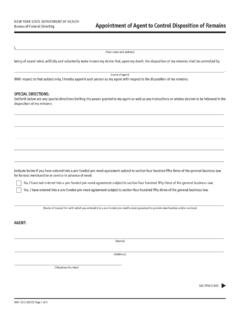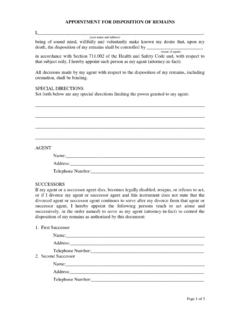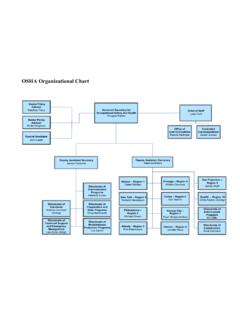Transcription of Guidance document transport of COVID-19 human remains
1 1 Guidance Information on the transport of COVID-19 human remains by Air 14 April 2020 Guidance Information on the transport of COVID-19 human remains by Air Collaborative document by WHO, CDC, IATA and ICAO Introduction Repatriation of human remains is the process whereby human remains are transported from the State where death occurred to another State for burial at the request of the next-of-kin. Repatriating human remains is a complicated process involving the cooperation and coordination of various stakeholders on several levels to ensure that it is conducted efficiently and in compliance with relevant international and national regulations.
2 Presently there is no universal international standard for requisite processing and documentation for repatriation of human remains by air. The Strasbourg Agreement of the Council of Europe ( ) has been agreed to by more than 20 States in Europe. Furthermore, there is no existing single source document that could provide harmonised Guidance to States and other interested parties. Considering requests received by WHO, IATA and ICAO on the transport by air of human remains where the cause of death was COVID-19 , there was a need to assess the risk of transporting human remains by air and to develop temporary COVID-19 specific Guidance material.
3 The objective of this document is to provide Guidance to aircraft operators, funeral directors and other involved parties concerning the factors that need to be considered when planning repatriation of COVID-19 human remains by air transport . Guidance for handling COVID-19 cadavers The COVID-19 pandemic has resulted in a considerable death toll and has raised questions regarding the repatriation of human remains where the person died of the disease overseas. Generally human remains are not infectious and do not transmit disease.
4 However, cadavers of persons who have died from contagious diseases may pose risk of transmission, but at a lower level than from living individuals except for viral hemorrhagic fever and prion diseases: International Society for Infectious Diseases (ISID): National Center for Biotechnology Information (NCBI): 2 Guidance Information on the transport of COVID-19 human remains by Air 14 April 2020 According to WHO and European Centre for Disease Prevention and Control ( ), there is no evidence to date of persons having become infected from exposure to the bodies of persons who died from COVID-19 .
5 Transmission of COVID-19 related to the handling of infected remains could occur through direct contact with body surfaces, tissues, fluids or their aspirates where the virus is present, or by direct contact with contaminated surfaces, clothing or other personal effects. Best practices to avoid COVID-19 infection under these circumstances include appropriate use of personal protective equipment (PPE) and thorough decontamination of surfaces and materials that have been in contact with remains Center for Disease Control & Prevention (CDC): BMJ Journals: Key issues to be considered when managing COVID-19 human remains include.
6 Providing specific Guidance as to appropriate PPE for funeral directors, religious leaders or others who may have direct contact with COVID-19 human remains , especially the importance of hand hygiene and personal protective equipment (PPE) when handling COVID-19 human remains ; respecting the dignity of the dead and their families according to cultural and religious traditions; encouraging practices that balance the rights of the family, the need to investigate the cause of death, and the risks of exposure to infection on a cases-by-case basis.
7 WHO has provided general guidelines for preparation and packing of human remains for non-air transfer to an autopsy unit, mortuary, crematorium or burial site that includes, procedures for autopsy and funeral preparation and local burial in the document Infection Prevention and Control for the safe management of a dead body in the context of COVID-19 . Options for air transport When a person has died from COVID-19 overseas, considerations for final disposition may include on-site cremation or internment at the location of death or repatriation of human or cremated remains to the State requested by the next-of-kin.
8 Many aircraft operators provide services for the transport of cremated and non-cremated human remains . These services vary according to the policies of each aircraft operator. In general, there are three possible options for the transportation of human remains by air: 1. cremated remains contained in a funeral urn, which is often the least complicated option. However, this is dependent on the personal, cultural and religious beliefs of the bereaved as well as national laws in the State of death; 2. embalmed human remains enclosed in a sealed coffin.
9 This option may be challenging since States may have opposing laws about embalming. For instance, legislation in the departure country may not allow embalming, while the destination country may require embalming for repatriation of the remains . In addition, some aircraft operators will only accept embalmed human remains . It should be noted that at the time of issue of this Guidance , WHO does not recommend the practice of embalming for COVID-19 remains to avoid excessive manipulation of the body; 3 Guidance Information on the transport of COVID-19 human remains by Air 14 April 2020 3.
10 human remains that have not been embalmed in an enclosed, sealed coffin. Specific requirements for this type of transport may vary by country, and States of departure or repatriation may not allow the export or import, as applicable, of non-embalmed remains . Different States might have different requirements. It is therefore important to consider several factors prior to deciding on the appropriate process for air transport . These factors include being aware of the applicable regulations and / or rules of the departure and destination States, including relevant documentation required as well as the requirements of the airline.
